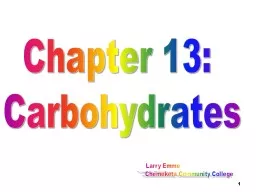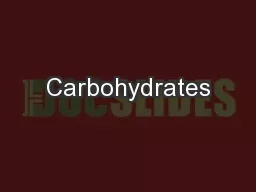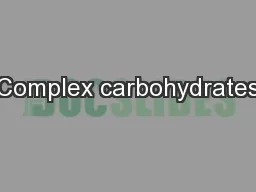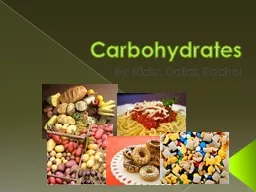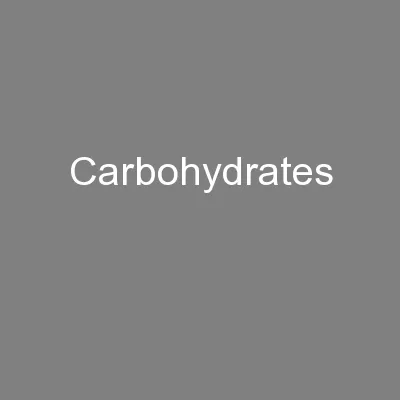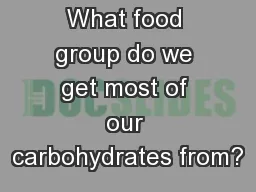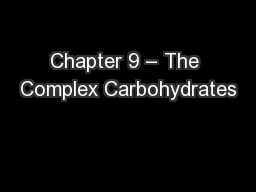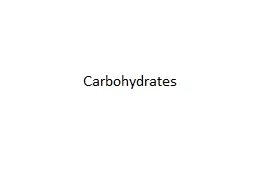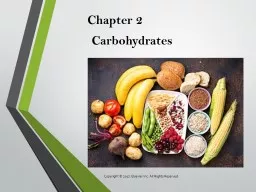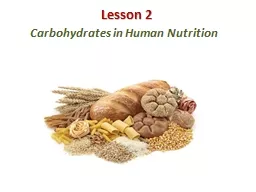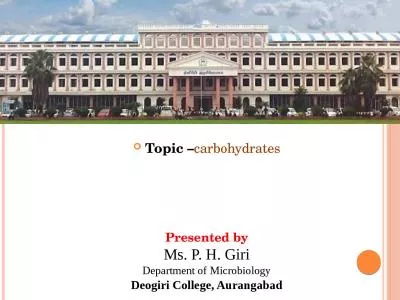PPT-1 Chapter 13: Carbohydrates
Author : min-jolicoeur | Published Date : 2018-12-16
Larry Emme Chemeketa Community College Chapter Outline Monosaccharides Fischer Projections Haworth Structures Diasaccharides Polysaccharides 3 Carbohydrates Carbohydrates
Presentation Embed Code
Download Presentation
Download Presentation The PPT/PDF document "1 Chapter 13: Carbohydrates" is the property of its rightful owner. Permission is granted to download and print the materials on this website for personal, non-commercial use only, and to display it on your personal computer provided you do not modify the materials and that you retain all copyright notices contained in the materials. By downloading content from our website, you accept the terms of this agreement.
1 Chapter 13: Carbohydrates: Transcript
Larry Emme Chemeketa Community College Chapter Outline Monosaccharides Fischer Projections Haworth Structures Diasaccharides Polysaccharides 3 Carbohydrates Carbohydrates. And 57375en 57375ere Were None meets the standard for Range of Reading and Level of Text Complexity for grade 8 Its structure pacing and universal appeal make it an appropriate reading choice for reluctant readers 57375e book also o57373ers students Complex and Simple. What’s the difference. Carbohydrates. Carbohydrates provide much of the fuel that keeps the body going.. Carbohydrates are the body’s most preferred source of energy. They make up the largest volume of our daily food. (60% of our food should be from Carbohydrates). Simple and Complex. Carbohydrates. Function-Energy Source. Carbohydrates are the body’s MAIN . source of energy. .. Carbohydrates. It is important that we ingest the “best” form of carbohydrates for our energy needs.. Ch. 9 A. Types of complex carbohydrates. Starches. Cellulose. Gums . Pectins. others. Starches. Polymers of sugar. Most abundant complex carb in the diet. Most have 100 to several 1000 . glucose. units in chains. By: Ricky, Dallas, Rachel. Vocabulary . Carbohydrates-one of the six classes of nutrients that includes sugars, starches, and fibers. Carbs are the body's main source of energy.. Monosaccharide- is a carbohydrate made up of single sugar units-glucose, fructose, and galactose. One of the three macro-nutrients. The main nutrient in grain products. Provides much of the fuel that keeps the body going. Carbohydrates. The body’s most preferred source of energy. 4 calories/gram. What are the three types of carbohydrates?. Carbohydrate Warm Ups. 3. What are two other common names for fiber?. 4. When a product claims that it is ‘whole wheat’ how many parts of the kernel are used? One two or three. Starches, Cellulose, Gums. and Pectins. Starches. – . most abundant complex carbohydrate in diet.. Composed of glucose . Main dietary source in U.S. is wheat flour. Nature’s reserve carbohydrate supply. Carbohydrates Carbohydrates serve a variety of functions E nergy storage and food Structure and support Lubrication Protection Recognition and signaling Component of nucleotides starch mucin (glycoprotein) Chapter 2 Carbohydrates Copyright © 2017, Elsevier Inc. All Rights Reserved. Lesson 2.1: Carbohydrates: Energy Source, Their Structures, Role as Fiber Carbohydrate foods provide practical energy sources because of their availability, relatively low cost, and storage capability. Human Nutrition. The role of carbohydrates in nutrition. The major dietary carbohydrates. Class (DP*). Subgroup. Components. Sugars. (1–2). Monosaccharides. Glucose, . galactose. , fructose, xylose. Carbohydrates. Are the most common type of organic compound. Examples: Starch or sugar. Is used to store energy. Are built in repeating units to make a larger molecule. Contain only carbon, hydrogen, and oxygen. 1 Compiled and Edited by Dr. Syed Ismail Associate Professor, SSAC College of Agriculture, VN MKV Parbhani 2 Carbohydrates C arbohydrates are broadly defined as polyhydroxy aldehydes or ketones and Presented . by. Ms. . P. . . H. . Giri. Department . of . Microbiology. Deogiri . College, Aurangabad. B.Sc. F. Y.. Semester II. Paper No. V. Basic Biochemistry. Unit 1 carbohydrates. Ms. . Priyanka.
Download Document
Here is the link to download the presentation.
"1 Chapter 13: Carbohydrates"The content belongs to its owner. You may download and print it for personal use, without modification, and keep all copyright notices. By downloading, you agree to these terms.
Related Documents

